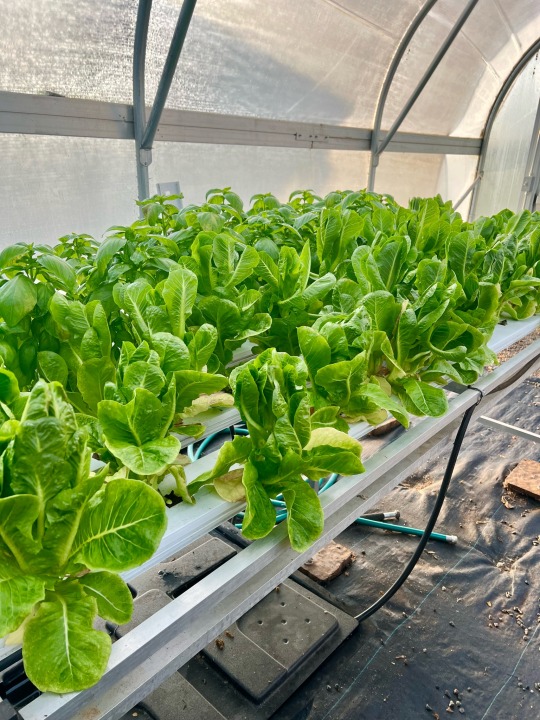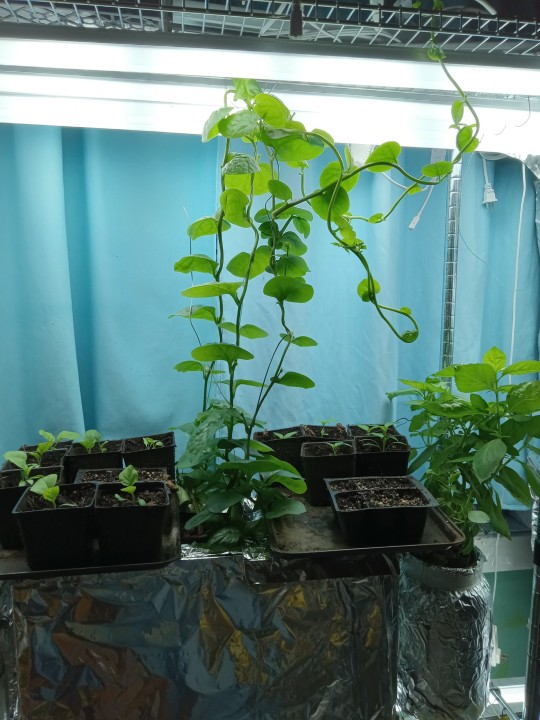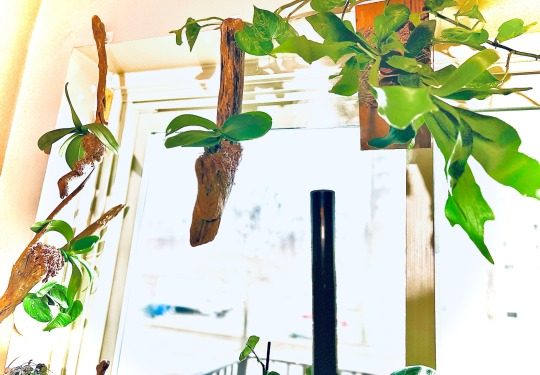#Indoor Hydroponics
Explore tagged Tumblr posts
Text
Find the Best Hydroponic System in India | Inhydro+

A Dutch bucket Hydroponic system is an effective way to grow plants without the need for soil. This type of system works by using buckets that contain a growing medium and nutrient solution. The buckets are connected by tubing which allows water and nutrients to be circulated throughout the system.
#Indoor Grow Lights#Hydroponic Grow System#Indoor Hydroponics#Hydroponic Grow Lights#Grow Lights For Plants#Hydroponic Garden#Hydroponic Garden Kit#Hydroponics Online Store India#Hydroponic Grow kit#Hydroponic Hobby Setup#Hydroponic Home Setup#Small Hydroponic System#Hydroponic Plants Indoor
1 note
·
View note
Text


9/19/23 ~ Hydroponics at school. Those cucumbers grew super fast 😳 and some Romaine Lettuce!
#indoor garden#container gardening#sustainable gardening#vegetable gardening#starting seeds#grow organic#grow your own food#organic gardening#tomato garden#green witch#greenhouse#greenhouse nursery#plant nursery#hydroponics#growing cucumbers#romaine lettuce#sustainable agriculture
66 notes
·
View notes
Text
It occurred to me that I hadn't talked about my malabar spinach on here, or at least I don't think I did.
So, basically, I wanted to try out a kind of hydroponics called the kratky method, and I found out I liked malabar spinach, so I stripped the leaves off a few stems and put them in an aquarium that I'd picked up from a free pile, and

They seem to be doing pretty well! Along with the Thai basil I also started from stems. Still learning how to do it well, but it's been a fun project so far. I haven't harvested any leaves yet, and I have a feeling I should figure out a better plan for the vines than "let them dangle".
23 notes
·
View notes
Text
5th harvest and update on the indoor hydroponic tomatoes 🍅 determinate/indeterminate
23 notes
·
View notes
Text
Hydroponics offers numerous benefits, including water efficiency, space optimization, faster growth, higher yields, year-round production, reduced pest pressure, nutrient control, and environmental sustainability. By eliminating soil and delivering nutrients directly to plant roots, hydroponic systems optimize resources, increase productivity, and contribute to a more sustainable food system.
#survivalism#preppers#survivalist#bushcraft#offgrid#homestead#nature#hydroponics#sustainability#sustainable#self sustaining#pro360products#indoors#outdoors#irrigation
11 notes
·
View notes
Text
Optimizing Indoor Agriculture: Vertical Grow Rack Systems
Using a vertical grow setup not only increases production but also enables precise control over light, temperature, and nutrients, resulting in healthier, faster-growing plants. Ideal for urban and indoor farming, vertical grow rack systems are helping meet the demand for fresh produce in urban areas while minimizing the use of land and resources. With the ability to grow a wide range of crops in a controlled environment, indoor vertical farming is paving the way for a more sustainable and efficient food production future.
2 notes
·
View notes
Text

Fresas hidropónicas 🍓
#garden#cdmx#mexico#hidroponía#hydroponics#strawberry#fresas#indoor plants#sun#fruit#growing up#desktop
3 notes
·
View notes
Text


We got our first flowers!! :D The tomatoes are also starting to put out flower buds but the angle is not great for taking pictures so just the bean flower for now!
2 notes
·
View notes
Text





Some of my babies. All are grown semi hydroponically, LECA, perlite or lechuza pon.
#house plant#leca#lechuza#plant mom#plant obsessions#plant photography#plantblr#plantcore#plantlife#plantlover#plants#hydroponics#houseplants#indoor plants#semi hydro#the leca queen#mounted plants#orchid#staghornfern#monsteralovers#philodendron#perlite#atabapoense#billietiae#hydro homies#roots love#plant collection#plant lover#plant posting#plant progress
25 notes
·
View notes
Text
Best Hydroponic NFT Channel | Inhydro

There are many great hydroponic NFT (Nutrient Film Technique) channels out there, but some of the best ones are:
Epic Gardening - This channel has a variety of hydroponic NFT content, including tutorials, product reviews, and tips on growing different types of plants using the NFT system.
Grow Ace - This channel has an extensive collection of hydroponic NFT content, ranging from product reviews to instructional videos on building your own NFT system.
Bright Agrotech - This channel specializes in vertical farming and hydroponic NFT systems. They offer a range of tutorials, tips, and advice on setting up and maintaining an NFT system.
Simply Hydroponics - This channel focuses specifically on hydroponic gardening and has a range of videos on different types of hydroponic systems, including NFT.
GreenJoy - This channel offers a range of hydroponic NFT content, including tutorials, reviews, and tips on growing various plants using NFT.
Overall, the best Hydroponic NFT channel for you will depend on your specific needs and interests. I recommend checking out these channels and seeing which one resonates with you the most.
#Hydroponic Farming India#Hydroponic Farming at Home#Hydroponics Training in Delhi#Hydroponic Training Courses#Hydroponic Farming Equipment#Best Indoor Hydroponic Plants#Hydroponic Plants Indoor#Small Hydroponic System#Hydroponic Home Setup#Hydroponic Hobby Setup#Hydroponic Grow kit#Hydroponics Online Store India#Hydroponic Garden Kit#Hydroponic Garden#Grow Lights For Plants#Hydroponic Grow Lights#Indoor Hydroponics
0 notes
Text


9/7/23 ~ Started school, been learning greenhouse hydroponic stuff & harvesting some veggies & flowers! I’m loving it so far.
I really need to start some of my seeds at home. I started pumpkin in august - I need to transplant it. And I have some Chinese broccoli growing as well. I don’t have a lot of experience with fall/winter gardening. So I’ll share as I go 😅 Trials and errors 😆
#indoor garden#container gardening#sustainable gardening#vegetable gardening#starting seeds#grow organic#grow your own food#tomato garden#sustainable agriculture#sustainable#horticulture#hydroponics#greenhouse
10 notes
·
View notes
Text
Moving this pretty variegated ivy over to leca from soil. Transitioning a plant to leca directly from soil can be tricky. How do you think this plant is doing?
.
.
.
Follow 💚@planthappyofficial for more planty content & visit us at planthappyproducts.com to learn more about planting hydroponic houseplants. 🫶🌱
#houseplants#leca#plants#indoor plants#plantlover#plantlife#plant parent#pon#exotic plants#hydroponics#ivy#rare plants
5 notes
·
View notes
Text
Building a DIY Hydroponic System: Unleash Your Inner Plant Scientist!
In recent years, hydroponics has gained popularity as a modern and efficient way of growing plants without soil. DIY hydroponic systems have become a favorite among gardening enthusiasts who want to take control of their food production and enjoy the benefits of fresh, pesticide-free produce. In this article, we will guide you through the process of building your own DIY hydroponic system, step by step. Whether you're a seasoned gardener or a novice, this guide will help you create a thriving indoor garden.
What is a DIY Hydroponic System?
A DIY hydroponic system is a method of growing plants in a soilless environment, using water, nutrients, and a growing medium. Instead of relying on traditional soil-based cultivation, plants are placed in a nutrient-rich water solution, allowing their roots to directly absorb the necessary elements for growth. This method provides several advantages, including faster growth rates, higher yields, and the ability to grow plants in limited space.
Benefits of a DIY Hydroponic System
Space Efficiency: DIY hydroponic systems are ideal for small spaces, as they can be tailored to fit any area, whether it's a balcony, a basement, or a spare room.
Water Conservation: Hydroponic systems use up to 90% less water compared to traditional soil-based gardening, making them an eco-friendly choice.
Year-Round Cultivation: With a hydroponic system, you can grow plants all year long, regardless of the weather conditions, extending your gardening season.
Pest and Disease Control: By eliminating soil, you reduce the risk of soil-borne pests and diseases, resulting in healthier plants.
Choosing the Right Setup
Before diving into the construction of your DIY hydroponic system, it's essential to consider the setup that suits your needs best. There are various types of hydroponic systems to choose from, including deep water culture (DWC), nutrient film technique (NFT), and drip systems. Each has its own advantages and considerations, such as space requirements, complexity, and the types of plants you can grow. Click here to buy!
Check out this tutorial to learn how to build your ebb and flow hydroponics system! DIY Ebb And Flow Hydroponic System.
Building Your DIY Hydroponic System
To build your own DIY hydroponic system, you'll need some basic materials and tools. Here's a list to get you started:
Reservoir (container to hold the nutrient solution)
Growing tray (where the plants will be placed)
Pump and tubing (to circulate the nutrient solution)
Lighting system (to provide the necessary light for plant growth)
Growing medium (to support the plants)
Nutrient solution (to provide essential plant nutrients)
Step 1: Determine the System Type
Decide on the type of hydroponic system you want to build based on your available space, budget, and personal preferences. Consider factors like ease of maintenance and the types of plants you want to grow.
Step 2: Build the Reservoir
The reservoir is where the nutrient solution will be stored. Choose a container that is large enough to accommodate your plants' needs and ensure it has a lid to prevent evaporation.
Step 3: Construct the Growing Tray
The growing tray will hold the plants and the growing medium. Construct a sturdy tray that fits your chosen system type and has proper drainage to avoid waterlogging.
Step 4: Install the Pump and Tubing
The pump and tubing will circulate the nutrient solution from the reservoir to the plants. Install them properly, ensuring the pump is reliable and the tubing reaches all areas of the growing tray.
Step 5: Set Up the Lighting
Lighting is crucial for plant growth, especially in indoor settings. Choose appropriate grow lights based on the plants you want to grow and position them at the correct height and angle to provide optimal light coverage.
Step 6: Add the Nutrient Solution
Mix the nutrient solution according to the instructions provided by the manufacturer. Fill the reservoir with the solution and monitor its pH and nutrient levels regularly to ensure healthy plant growth.
Step 7: Planting and Maintenance
Plant your chosen seeds or seedlings in the growing medium, ensuring they are properly spaced. Monitor the system regularly, checking pH levels, nutrient concentrations, and water levels. Make adjustments as necessary and prune plants when needed.
Troubleshooting Tips
If plants show signs of nutrient deficiencies or excesses, adjust the nutrient solution accordingly.
Ensure the pH levels are within the appropriate range for your chosen plants.
Keep an eye out for pests or diseases and take prompt action to prevent their spread.
Regularly clean and maintain the system to avoid clogs and blockages.
To learn how to build your vertical hydroponics system, check out this tutorial! Vertical Hydroponics DIY
Conclusion
Building your own DIY hydroponic system opens up a world of possibilities for indoor gardening. With a well-designed setup and the right care, you can enjoy fresh and healthy produce throughout the year. Experiment with different plant varieties and explore the fascinating world of hydroponics. Start your journey towards sustainable and efficient gardening today! Don't forget to choose these tools from Shopbestgoods.com!
FAQs
1. What vegetables can I grow in a DIY hydroponic system?
Leafy greens like lettuce, spinach, and kale, as well as herbs like basil and mint, are popular choices. You can also grow tomatoes, cucumbers, peppers, and strawberries.
2. How often should I change the nutrient solution?
It's recommended to change the nutrient solution every two to three weeks to maintain the proper balance of nutrients. However, monitor the solution's pH and nutrient levels regularly and adjust as needed.
3. Can I use tap water for my hydroponic system?
Tap water can be used in a hydroponic system, but it may contain chemicals like chlorine or high mineral content. It's advisable to filter or treat the tap water before using it to ensure optimal plant health.
4. Do I need to adjust pH levels in a hydroponic system?
Yes, maintaining the correct pH level is crucial for nutrient uptake by the plants. Most plants thrive in a pH range of 5.5 to 6.5. Use a pH testing kit and adjust the pH using pH-up or pH-down solutions if necessary.
5. Can I use a DIY hydroponic system for indoor gardening?
Absolutely! DIY hydroponic systems are particularly well-suited for indoor gardening. With proper lighting and care, you can enjoy the benefits of growing your own fresh produce in the comfort of your home.
#hydroponic#hydropnics#indoor gardening#indoor growing#hydroponic system#hydroponic box#ShopBestGoods#hydroponic garden#hydroponic farming
3 notes
·
View notes
Text
How much electricity does indoor hydroponics use? (Not much) :D
10 notes
·
View notes
Text
Indoor Micro Green Growing: Everything You Need to Know
Growing microgreens indoors is a fun and easy way to incorporate fresh greens into your diet all year round. Here are the steps to grow microgreens indoors: Choose your container: You can use any shallow container with drainage holes. You can also use seed trays, recycled plastic containers or even a baking tray. If a container has no drainage holes, it can lead to waterlogging of the growing…

View On WordPress
3 notes
·
View notes
Text
Ebb and Flow Tables in a Greenhouse
This system works by periodically flooding the grow tray with nutrient-rich water, which then drains back into a reservoir, allowing the roots of the plants to absorb the nutrients and oxygen they need.
2 notes
·
View notes